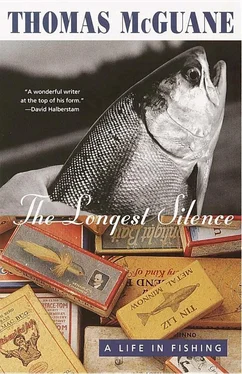The marine shallows where the bonefish spends much of its existence, from the transparent larval stage to maturity, are accessible only to the fisherman or scientist who either wades or transports himself in a light skiff over the sand and turtlegrass. As much delicacy of approach is required of these observers as there is of the ornithologist. This essential condition of bonefishing makes it almost generically different from offshore angling.
Unlike almost any other game fish, the bonefish are not sought where they live. They live in deep water and only do some of their feeding on the flats. A trout fisherman, for example, seeking a particular fish, would attempt to ascertain where that fish lived, in which pool or under which log. The bonefisherman never has any idea where any given fish lives; he attempts to find combinations of tide and place that are attractive to feeding bonefish. Occasionally, a single fish will appear with certain regularity, but this is exceptional.
Flats used by feeding bonefish are flooded by tide. They are flooded at unequal rates, depending on the location of the individual flats relative to the direction of tidal bore and current, and the presence of keys and basins, which draw and deflect the moving water. One flat, for instance, might have rising water while another, located a mile away, may not get its first incoming water until an hour later. Even this is not constant, since wind can alter the precise times of rising and falling water.
The beginning bonefisherman often feels humiliated to learn that flats he found empty could produce bonanzas for anglers with a better sense of timing. A tide book and a good memory are the first tools of the bonefisherman. With experience, a pattern begins to emerge — the shape of the life habits of a wild species.
The novice starts with a simple combination — early incoming water in the morning or evening — and gradually, by observation, begins to include the mosaic of tidal information that finally becomes the fabric of his fishing knowledge. Tide in the Tropics, where only a foot of water moves on the average, seems rather ethereal to the new bonefisherman. To him it hardly seems reasonable that three- or four-tenths of a foot of tidal variation can mean the difference between a great and a worthless fishing tide.
Tide can work in another way: you are poling across a flat in less than a foot of water. A fish tails high on the flat. You begin your approach, closing in deliberately. There is the small sound of staghorn crunching against the skiff’s bottom, then the more solid sound of sand. You can’t go any farther. The bonefish is still tailing, still out of reach. You get out of the skiff and wade toward him to make your cast. His tail disappears as he tilts out of his feeding posture, follows your lure or bait, takes, is hooked and running. For ten minutes you live as never before. Then the bonefish, a fine eight-pounder, is released.
When you return to the skiff, it’s high and dry; the tide has dropped out from under it. You’ve got a six-hour wait before you can budge the skiff, so you pace up and down the flat like an angry executive. If you’re a smoker, you smoke more than you have ever smoked before. Can’t someone get me out of this?
Now, if you have gone aground in the morning on a summer’s day and have not brought water, you will be truly sorry. If you have gone aground in the afternoon and can’t find your way home in the dark, you’ll be sleeping in the skiff. Pick a breezy place where the mosquitoes have taxiing problems; a certain number will crash-land on your person anyway, but the breeze will discourage the rank and file. Curl up in your little flats boat, listen to the wave-slap, and, watching the deep tropical night, think upon the verities of your choice. Tantrums, it should be mentioned, only keep you from getting to sleep.
Tide, that great impersonal pulse of earth which brought you that eight-pounder on a platter, has cooked your goose.
Bonefish are hard to see. You train your eyes to find them by a number of subliminal signs which, after you have fished the flats extensively, give you the opportunity to amaze your friends with feats of vision. “Bonefish right in front of you!” you say as one ghosts past the skiff, visible only by the palest shadow it casts on the bottom.
“Where?” asks your good friend, whom you really shouldn’t treat this way. “My God, where?”
“Right in front of you!” This starts your companion casting, even though he sees nothing.
“Flushed fish,” you say, gazing at the horizon.
The difficulty in seeing fish gives the veteran a real opportunity to lord it over the neophyte, gives him a chance to cultivate those small nuances of power that finally reveal him to be the Captain of the Skiff. After that, the veteran can relax and radiate generosity.
Of the fish that concern the flats fisherman, bonefish are the smallest and probably the hardest to see. Water and light conditions dictate how they are to be sought with the eye, but again intuition eventually takes over. In the Florida Keys, where bonefish are characteristically seen swimming rather than tailing (and perhaps this is true everywhere), you must make a disciplined effort to look through the water surface. While it is certainly something very inviting to look at, the man who confuses angling with relaxation and lets his eye linger here will miss nine out of ten fish. In the beginning, especially, the task must be borne down on, for it is hard work. Eventually you will learn to sweep, or scan back and forth, over the area of possible sighting. At the first sweep, your mind records the features of the bottom; on subsequent scans, if anything is out of place or if the small, unobtrusive, and utterly shadowy presence of a bonefish has interrupted those features in your memory, you will notice it.
Polaroid glasses are an absolute necessity. There is some disagreement about which color is best. Green lenses are the most common, but things show up a little better with amber. Many people find the amber lenses hard on their eyes on brilliant days and so confine their use to overcast skies. I have used the amber glasses on brilliant July days and been plagued by headaches and strobelike afterimages.
In very shallow water, bonefish manifest themselves in two other ways: by waking and by tailing. Fish making waves are often seen on the early incoming tide, and I think these are more important to the angler than the tailing fish. Singles make a narrow V wake, not always distinct, and pods of fish make a trembling, advancing surface almost like a cat’s-paw of wind, called “nervous water.”
The most prized discovery, however, is the tailing fish. And wading for tailing fish is the absolute champagne of the sport, the equivalent of dry-fly fishing during the hatch. These fish can be harder to take than the swimmers — their heads are down and it is necessary to get the fly near them so they can see it, yet this close presentation tends to frighten them — but the reward is commensurately greater and the corollary that they are usually hooked in the shallowest kind of water makes their runs even more vivid. Since there is often more than one fish tailing at the same time, the alarm of a hooked fish is communicated immediately and its companions will explode away from the site like pieces of a star shell.
The sound that a hooked bonefish makes running across a flat cannot be phonetically imitated. In fact, most of the delicate, shearing sound comes from the line or leader as it slices through the water. The fish will fight itself to death if not hurried a little and if care is not taken in the release.
Anglers of experience speculate a good deal about the character of their quarry, doting on the baleful secrecy of brown trout, the countrified insouciance and general funkiness of largemouth bass, or the vaguely Ivy League patina of brook trout and Atlantic salmon. The smallmouth enthusiast who accedes to a certain aristocratic construction to his sport is cheerful and would identify himself with, for instance, Thomas Jefferson, whose good house (Monticello) and reasonable political beliefs about mankind (democracy) have been so attractive to the optimistic and self-made.
Читать дальше












